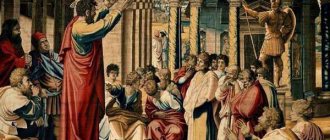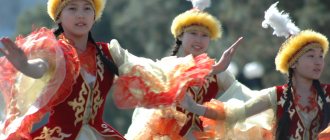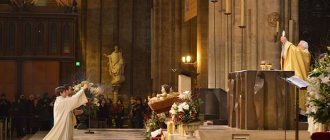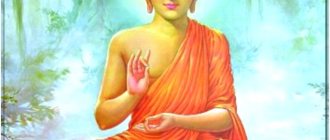The dominant religion of Japan is Shintoism. Buddhism is widespread almost equally with it. Many Japanese believers recognize themselves as followers of both directions at the same time. In 1886, Shintoism was recognized as the state religion, but this status has been lost since 1947. Communities of Christians, Muslims, and adherents of other movements are less numerous. In the past, many people in the country believed in animism and totemism. In addition to the main religions, there are several sectarian movements.
Shintoism is the main Japanese religious doctrine
Ancient Religions of Japan
The earliest religion among the indigenous Japanese is fetishism. Its object was a stone. Historians associate this with the development of technology - people learned to make tools from minerals. Pebbles became the first religious fetish. Already today, painted pebbles have been found in ancient temples, visually similar to Australian churinga. Both the Japanese and Australians believed that the stones contained children's souls. There are known legends about the stone near Funaho, a village in Kyushu. He called for rain and helped to conceive a child. In Fukuoka, two egg-shaped stones were worshiped. They believed that they attracted success and simplified childbirth.
Another evidence of the religion of fetishism in Japan is the Uwappara Shrine. It preserves stone pillars grouped into 3 blocks, forming a circle. To the north of them there are piles of stones piled above pits with coal. Historians suggest that the second fetish was fire.
Uvappara Sanctuary
Totemism
Totemism is a religion of ancient Japan, explained by the structure of the tribal community. With totemism, blood, family relationships of a person are transferred to nature. Associations appear with flora and fauna, on which the life of people in the Neolithic greatly depended. First, the cult of the Heavenly Deer, the elk, appeared. The Japanese believed that they were the first representatives of the fauna. Traces of this cult are found in ancient rituals of fortune-telling by reading a deer’s shoulder blade over the hearth. They are known not only to the Japanese, but also to the Mongols. Presumably, people saw off the souls of eaten animals on shell heaps. They believed that this way they would be able to return to give people food again.
Another evidence of ancient Japanese religions is the names of some areas. For example, Kumamoto Prefecture received its name due to the community's worship of bears. People believed in origin from this beast. These beliefs were especially strong among the ancestors of the Ainu. It is known that they buried bear bones along with human bones.
Japan's traditional religion contains echoes of the past. And today the inhabitants of the Land of the Rising Sun revere foxes, reptiles, and monkeys. There are traces of totemism in fairy tales - for example, about the phoenix Hoo, who combined the features of birds, snakes, fish and a turtle.
Trees revered in totemism:
- among the Ainu - elms;
- among the Japanese, Mongols, and Manchus - pine;
- among the Japanese - cypress, wild orange.
These trees were considered the patrons of the community, so it was under them that rituals and places for exchange were organized.
Pine is a sacred tree
Animism
Animism is an idea of the structure of the world, widespread in primitive society. The ancient Japanese believed in the spirituality of the world around them and the existence of spirits. Since the Yayoi era, a new religious cult of ancestors has appeared, the concepts of “oharai” (purification ritual), “kami” (god). This is how the foundations of Shinto are laid.
The central idea of animism is the soul as a life principle. This religion is characteristic not only of eastern countries - it is found in the works of Aristotle, the works of the Stoics, Thales of Miletus, Lucretius. The ethnographic term for religion was introduced by E. Tylor, who explained the origin of the movement with the reasoning of a certain savage philosopher who was looking for the causes of dreams and death.
Mount Haguro - the center of Japanese animism
Taoism
Taoism itself has never been particularly popular in Japan. However, the influence of Chinese Taoist legends on Japanese culture and literature is quite significant.
The basis of the teachings of Tao is considered to be the work of the Chinese philosopher Lao Tzu “Tao Te Ching”. From the point of view of Taoism, the universe exists due to the inexplicable Tao (“Path”), which moves and controls all things. Following the laws of Tao is the path of life and bliss.
Practical Chinese understood Taoism as the study of the laws of nature and the universe. The Taoists, the sages who comprehended the Tao, were credited with eternal life and various magical skills. It was Taoism that gave birth to Far Eastern alchemy, the main interest of which was not the “philosopher’s stone” of European alchemists, but the search for the “elixir of immortality.” Taoists who achieved immortality were called “sennin.” It was believed that they, like the Yamabushi, lived as hermits in the mountains. Various stories about great Taoists and recipes for immortality crossed the sea and became very popular in Japan.
In many ways, it is on these legends that the art of Onmyodo (“The Way of Harmony of Yin and Yang”) is based – the Japanese art of summoning and controlling demons, fortune telling, astrology, magical healing, and so on.
Modern religious composition of the country
The modern religious world of Japan is predominantly subject to the laws of Shinto and Buddhism. Separate surveys show that up to 84-96% of the country's believing population adhere to these movements. The state is characterized by syncretism, that is, many citizens follow two doctrines at once. The difficulty of counting is related to the associations of the population with specific temples. According to some researchers, only every third Japanese considers himself a believer.
The dominant beliefs in Japan are determined not only by the internal development of society, but also by external influence, in particular Chinese, which educated noble circles helped spread. The Way of Tao, the teachings of Confucius, Buddhism came to the Land of the Rising Sun from its mainland neighbor. This influence developed with internal religious practices, but did not replace them, so modern Japanese practice Shinto rituals, but often get married in Christian temples, and organize funerals in Buddhist ones. The 19th century became a new milestone in the history of religion in Japan - sects appeared. Most are unknown outside the country, but some have made news around the world due to their activism.
The peculiarity of beliefs in Japan is syncretism
Shintoists
When talking about Japanese religions, one usually thinks of Shinto shrines. Shintoism is a national traditional religion. It has no origin or founder, no sacred books. Shinto is the way of worshiping natural phenomena and the souls of ancestors. The supreme being is Amaterasu Omikami, the solar goddess, the ancestor of the imperial family. Shintoism is a national worldview that has shaped the uniqueness of the Japanese. This is the main religious movement, the name of which consists of the words “god” and “path”. This is a symbolic name that reflects the idea of the presence of spirit in each object. It is believed that these souls protect, protect, and help people.
There are approximately 80,000 temples in Japan; 27,000 clergy. Temples are divided into two areas: the prayer hall and the hoden, where the sacred object is kept. Rituals are carried out in temples and at home. Before the ritual, wash your hands thoroughly and rinse your mouth. When finishing, they drink a sip of sake - a symbol of the divine gift.
The main idea of Shinto is the harmony of man with nature. It is associated with Japanese philosophy, customs and culture of the country. Many perceive Shinto as an element of a specific national culture.
Fushimi Inari Shrine
Buddhists
Religious teaching originates from India, and came to Japan from China approximately in the 6th century. Some sources indicate other dates - IV, V centuries. At first, religion did not attract the attention of society. The turning point occurred in the 6th century, when Buddhism was adopted by nobles in the capital Asuka. The Soga clan chose a new religion and won the confrontation with the Minonobe, who supported the old religious system. For ordinary Japanese, Buddha was a foreign kami. The preachers did not fight the old teachings, but used them to their advantage. It is known that Buddhist temples were built only after the consent of Shinto deities. The buildings themselves were created according to Chinese prototypes. Sacred utensils were delivered from there.
In modern Japan, traditional and neo-Buddhism are distinguished. The first is the schools that have formed over many centuries. All traditional organizations are united by the All-Japan Buddhist Association, which includes about 60 groups. The largest group is Soto-shu. She owns about 14,700 temples. The clergy of these schools are rarely interested in social and political problems. Mostly these are conservatives who support the current system.
Buddha in Kamakura
Christians
Surveys show that there are just under 2 million Japanese Christians. The bulk falls on the western regions. 60% of those who recognize themselves as Christians are residents of the capital and Kanagawa. This is explained by the historical context: the port of Yokohama was accessible to foreigners.
Japanese Christianity dates back to 1549, when Francis Xavier arrived in Kagoshima. As a missionary, he began working in the south, baptizing several large feudal lords. The authorities did not approve of the new movement, religion was banned. This led to the formation of hidden Christians who secretly followed their chosen teaching.
At first, Christians were persecuted
Confucians
The trend of borrowing from China, which influenced all spheres of the cultural and social life of the Japanese, affected religion. One of the consequences was the spread of the teachings of Confucius. It became famous in Japan at an early stage of development thanks to the Koreans and Chinese who migrated to the islands. The newcomers brought with them sacred texts, customs and ways of life that influenced the indigenous population. In the 17th century, the church became a tool to help keep citizens obedient. This environment turned out to be favorable for the teachings of Confucius. In the form of Neo-Confucianism, the religion spread throughout the country.
The peculiarity of Confucianism is the unity of ethical norms, rules of behavior in society, and population management practices. It is often said that Confucianism cannot be called a religion, since in its characteristics it is rather a moral teaching.
Confucius with his students
Cultists
Only a few Japanese religious sects are known outside the country. Followers of even the largest sects are Japanese citizens; the number of foreigners among students is vanishingly small.
The most famous:
- Aum Shinrikyo;
- Soka Gakkai;
- Ray Yu Kai.
There is no exact information about the number of sects and the number of followers. All organizations are divided into groups:
- neo-Confucianism;
- neo-Shintoism;
- metabuddhism;
- religious agreement.
Most sects are neo-Buddhist, associated with Nichirenism. The Japanese call them new religions. Some researchers believe that in the 80s of the last century there were more than 20 neo-Buddhist directions in the Land of the Rising Sun, and their followers numbered in the millions.
Most Japanese sects are officially represented by lay communities. They are considered an integral part of the life of society and influence politics and economics. Syncretic sects appeared recently as an experiment in uniting Buddhism, Christianity, and philosophical movements.
Tokyo Soka Gakkai Memorial Hall
Believers of other religions
Islam in Japan is predominantly characteristic of emigrants. The main share are Tatars and Pakistanis. The mosque was first erected in 1905 in Osaka. The Muslim Tokyo Society was founded by the Bashkir Kurbangaliev. The Japanese Muslim school opened in 1927, and a year later the All-Japan Muslim Congress was held for the first time. Another 10 years later, the Tokyo mosque was opened. Islam as an active religion was recognized in the country in 1939. The number of followers is several hundred thousand people.
Other religious communities:
- Hindus (less than 30,000 believers);
- Baha'is (about 15,000 followers);
- Sikhs (about 2,000 people);
- Jains (just over 1,500 members);
- Jews (about 1,500 supporters).
About 10,000 Japanese declare themselves followers of primitive religious movements.
Representatives of Japanese Muslim society
Atheists
Atheism is spreading throughout the world. This growth is especially replaced by the results of sociological studies conducted in the United States. Many people claim that they do not believe in God, but do not call themselves atheists. Only every fourth non-believer considers himself to be part of this community.
Statistical studies show that Japan is second only to China in terms of irreligiosity. On average, 47% of Chinese are convinced atheists; in Japan, 31% consider themselves to be such.
A survey to assess irreligiosity showed that Japan ranks 2nd in the world, second only to China. About 16% of the country's population consider themselves believers (2% more than is typical for China).
Buddhism in Japan
Several historical Chinese documents mention 5 monks who set sail to the islands. They carried with them religious images and sutras. The educators who landed in Japan told the population about the new teaching, called on them to abandon passions and attachments, putting peace of soul first. Japanese chronicles associate the emergence of Buddhism with Korean enlighteners.
The population of the country received the new teaching favorably, although some conflicts could not be avoided. Gradually, the situation escalated and resulted in a confrontation between two large clans striving for undivided power over the country. Religion became the formal reason for armed confrontation. Victory remained with the family that propagated Buddhism. From that moment on, the movement received official recognition.
The country's rulers supported the new religion. Prince Shotoku left personal notes on the sutras and contributed to the construction of the first temples, and Emperor Shomu established the status of a state religion. The development of Buddhism led to the identification of 6 Nara schools, whose ideology boiled down to the following:
- the world is unreal, follows from individual perception;
- life is suffering due to a cause that can be found and eliminated;
- the golden mean is the path of the adept;
- emptiness, the absence of one’s own nature, is the world’s basis.
Buddhism in Japan has absorbed local customs, so it is very different from Chinese. It developed in conditions of isolation, so the ancient provisions were preserved in better shape. Japanese adherents have the right to judge for themselves what is wise and eternal, while Chinese teaching takes into account only the collective and the indisputable authority of the teacher.
Japanese Buddhism merged with Shintoism. This led to the emergence of the dual path of spirits - Rebu Shinto. The Shingon sect, which promoted the cult of Buddha Vairocana, the symbol of the Universe, had a strong influence. Shinto kami were perceived as Buddhas, Amaterasu - Vairochan.
Over the centuries, the role of the clergy became greater and its influence on power became stronger. The Tendai sect had the main privileges. First it was used by emperors, then by the shogunate. Political changes led to religious changes and the development of Zen Buddhism. Zen spread among the samurai, among the elite of society. The rituals and spiritual practices of that era became the basis for the development of all areas of public life - from the tea ceremony to art.
Todai-ji in Nara
Shinto - the way of the gods
According to the general consensus of scientists, the ancient religion on the islands of Japan developed separately from the Chinese, and reliable sources of its origin have not yet been found. It is called Shinto, or the way of the gods. To tell the truth, for most Japanese the origin and essence of this religion is not so important; for them it is at the same time a tradition, history and life itself.
Shinto can be compared to ancient mythology, and the meaning and purpose of Shinto itself is to affirm the originality of Japanese culture and the divine origin of its people. According to this religion, first there appeared the emperor (mikado), who is a descendant of heavenly spirits, and then each of the Japanese - his offspring (kami). In this case, the object of worship is considered to be the ancestors, or more precisely, the souls of deceased patrons of families.
Features of Confucianism in Japan
Confucianism is an ethical, philosophical movement that appeared 2.5 millennia ago in China. In Japan, it underwent changes as it developed outside the conditions of Chinese conformity. The spread of the teachings of Confucius in the Land of the Rising Sun is due to the closeness of its provisions to the traditional cult of ancestors.
Confucianism appeared in Japan later than Buddhism, so the preachers of the new path met with a wary attitude. It combines teaching, religion; is aimed at moral teaching of youth, showing respect for elders, and love of humanity.
Confucianism in Japan is associated with the policies of the Tokugawa shogunate in the 17th century. The movement to centralize power turned the church into an instrument to ensure the obedience of ordinary people. Neo-Confucianism, promoted by the shoguns, seemed to be a source of power through the ideals of devotion to a teacher, an elder. Its main idea is the division of society into insignificant and noble, which are characterized by 5 features:
- humanism;
- courtesy;
- intelligence and education;
- call of Duty;
- loyalty.
Equally important in Confucianism is respectfulness, one of the basic human virtues. In the Middle Ages in Japan, Confucian literature of an edifying nature was formed. For Japanese followers, Confucius himself, from a Chinese sage, became a representative of Eastern wisdom, which the whole world will eventually come to know.
Confucian ideas have permeated Japanese society since the Tokugawa period. They defined adherence to the canons, humility, respect, relationships in society, generosity, peace and harmony, economy and moderation in life. These canons determined the importance of agriculture and silk production - areas that provided the population with clothing and food. Important Confucian dogmas:
- learning is fundamentally important for a person;
- it is permissible to follow only the true path;
- it is important to explain the laws to everyone;
- Having chosen a business, you need to work hard;
- To protect the younger generation from bad deeds, moral teachings and teachings are enough;
- false accusations are unacceptable;
- harboring fugitives is illegal;
- taxes must be paid in full;
- to combat crime it is necessary to unite the efforts of the community;
- suppression of anger elevates the personality.
These postulates influenced public consciousness and became the basis for the formation of behavioral stereotypes. For modern Japanese, these dogmas have lost the significance characteristic of medieval residents, but continue to largely regulate social processes.
Confucianism came to Japan later than Buddhism
Predominant religion
Research to determine the dominant religion and the number of believers was organized by the Japanese Agency for Cultural Affairs. Surveys have shown that the number of believers is more than 180 million. This figure is noticeably higher than the official number of Japanese citizens, since many adhere to several directions at the same time. Among those surveyed, the majority declared adherence to Buddhism - almost 88 million. Shintoism as a religious doctrine was mentioned by about 85 million.
The syncretism characteristic of the Japanese does not allow one to strictly identify a single dominant religion. Both Shintoism and Buddhism are equally revered and respected, and most Japanese believers adhere to both schools simultaneously.
In Japan there is no prejudice against holidays that come from other religions. Many citizens celebrate the last day of the year at a Buddhist shrine, having previously celebrated Christian Christmas or Halloween. On the first day of the New Year, it is customary to make a pilgrimage to a Shinto shrine. Buddhist and Shinto prayer corners are installed in homes.
Syncretism is a feature of Japan
Written sources
The main religious documents of Shintoism are two collections of myths - Nihongi and Kojiki, written by the emperor's courtiers after 712, as well as detailed instructions with ancient prayers and rituals - Engishiki. Historians believe that since these written sources appeared much later than the events in question, the original spiritual practices and beliefs of Shintoism may be somewhat distorted. But, be that as it may, it is clear from them that the ancient Japanese, whose religion and traditions were centered mainly around their family and clan, as well as agricultural holidays, idolized life.
Shamans, who performed the duties of cult ministers and spoke with believers on behalf of their ancestors (kami), were considered warriors who fought against evil spirits. They invoked the gods using Kagura - sacred dances traditional for this religion, performed by young girls. It is safe to say that much of traditional Japanese art, music and literature has its roots in the ancient shamanic rituals of Shintoism.
Magic and religion of Japan
Shinto is the ancient religious way of the Japanese. The national religion says: the emperor is the grandson of the Sun. In Shinto there is the concept of the rice man (the god of Food), as well as the deities of Water, Fire, and the reproductive member. The Japanese especially believe in the power of the demonic fox Inari. Stories and legends speak of her ability to modify the world around her and herself.
Modern Everyday Japanese Magic:
- those who want to attract wealth acquire a wooden amulet in the form of a kite;
- a fan decorated with fiery tongues and wise words protects against fire;
- a prediction purchased from a priest will come true if you tie it to a tree branch;
- three Nikko monkeys made from wood will ward off demons and diseases.
In former times in Japan there were anmiyoji - magicians and advisers to rulers.
The main modern magical action is the mark. A five-pointed star enclosed in a circle has a special magical effect. For writing, they used special paper, which was then folded along strictly defined lines. Paper is the second magical object. The third is sound. The main Japanese spell is the human name. The Japanese believe that magical power lies in the heart.
Three monkeys from Nikko
Ritual of cleansing
Perhaps the Japanese take it most seriously. The Shinto religion traditionally requires special purity. For example, a woman who goes to worship before reaching the main shrine must stop to take a ritual bath. After this, she burns incense or makes an offering by placing a coin in a special donation box.
Approaching the sanctuary, the woman must turn to face the altar and, bowing her head, clap her hands twice, and then clasp her hands in front of her face, palms together. This ritual is intended for summoning kami, but it can also be performed at home. The fact is that in many Japanese houses there are kami-dana - small family altars where they carry out the ritual of honoring ancestors.











